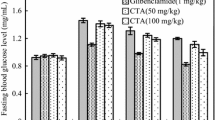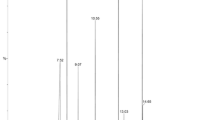Abstract
Quercetin (QE), one of natural flavanoid group, was widely distributed as a secondary metabolite in plant kingdom. It has been believed that oxidative stress plays a role in the pathogenesis of diabetes mellitus (DM). The aim of the present study was the evaluation of possible effects of QE on blood glucose and antioxidant enzymes in experimental streptozotocin (STZ)-induced diabetes in rats. STZ was injected intraperitoneally with single dose of 50 mg/kg for diabetes induction. QE (15 mg/kg bw day, intraperitoneal (i.p.) injection) was injected for 3 days prior to STZ administration; these injections were continued to the end of the study (for 25 days). Glucose tolerance test and random plasma glucose were done for all animals. Cellular antioxidant enzymes such as glutathione peroxidase (GSHPx), superoxide dismutase (SOD) and catalase (CAT) activities were measured in pancreatic homogenates. Quercetin had no effect on plasma glucose level of normal animals but its pre- treatment was able to prevent diabetes induced by single intraperitoneal injection of streptozocintreated rats. Antioxidant enzyme activity significantly decreased in STZ induced diabetic group. QE treatment significantly increased the antioxidant enzyme activities. It could be concluded that quercetin, a flavonoid with antioxidant properties, exerting its beneficial antidiabetic effects.
Similar content being viewed by others
References
Baynes J, Thorpe S. The role of oxidative stress in diabetic complications. Curr Opin Endocrinol 1996; 3: 277–284.
Ihara, Y, Toyokuni S, Uchida K, Odaka H, Tanaka T, Ikeda H. Hyperglycemia causes oxidative stress in pancreatic beta cells of GK rats a model of type 2 diabetes. Diabetes 1999; 48: 927–932.
Kanter M, Meral I, Dede S, Gunduz H, Cemek M, Ozbek H. Effects of Nigella sativa L. and Urtica dioica L. on lipid peroxidation, antioxidant enzyme systems and some liver enzymes in CCl 4-treated rats, J Vet Med A Physiol Pathol Clin Med 2003; 50: 264–268.
Bray T, Bettger W. The physiological role of zinc as an antioxidant, Free Radic Biol Med 1990; 8: 281–291.
Rizk A, Hammouda F, Rimpler H, Kamel A. Iridoids and flavonoids of Teucrium polium herb. Planta Med 1986: 2: 87–88.
Middleton J. Effect of plant flavonoids on immune and inflammatory cell function. Adv Exp Med Biol 1998; 439: 175–182.
Laughton M, Evans P, Moroney M, Hoult J, Halliwell B. Inhibition of mammalian 5-lipoxygenase and cyclo-oxygenase by flavonoids and phenolic dietary additives. Relationship to antioxidant activity and to iron ion-reducing ability Biochem Pharmacol 1991; 42: 1673–1681.
Pari L, Saravanan G. Antidiabetic effect of cogent db, a herbal drug in alloxan-induced diabetes mellitus. Comp Biochem Physiol 2002; 131: 19–25.
du Thie G, Crozier A. Plant derived phenolic antioxidants. Curr Opin Clin Nutr Metab 2000; 3: 447–451.
Fuhrman B, Aviram M. Flavonoids protect LDL from oxidation and attenuate atherosclerosis. Curr Opin Lipidol 2001;12: 41–48.
Estany S, Palacio J, Barnadas R, Sabes M, Iborra A, Martínez P. Antioxidant activity of N-acetylcysteine, flavonoids and α-tocopherol on endometrial cells in culture. J Rep Immunol 2007; 75: 1–10.
Un J, Mi-Kyung L, Yong B, Mi A, Myung-Sook C. Effect of citrus flavonoids on lipid metabolism and glucose-regulating enzyme mRNA levels in type-2 diabetic mice. Int J Biochem Cell Biol 2006; 38: 1134–1145.
Maria M, Kyriakos R, Dimitrios G. Protection against nuclear DNA damage offered by flavonoids in cells exposed to hydrogen peroxide: The role of iron chelation. Free Rad Biol Med 2005; 39: 1591–1600.
Sara R, Seymour G, Radim J, Blanka B, Ivan K, Lyubomirova K, et al. Effects of diet on biomarkers of exposure and effects, and on oxidative damage. Mutation Research/Fundamental and Molecular Mechanisms of Mutagenesis 2007; 620: 93–102.
Zapolska-Downar D, Kosmider A, Naruszewicz M. Flavonoids-rich extract from chokeberry fruits inhibits oxLDL-induced apoptosis of endothelial cells. Atherosclerosis (Suppl) 2006; 7: 223–224.
Hii C, Howell S. Effects of epicatechin on rat islets of Langerhans. Diabetes 1984; 33: 291–296.
Young P, Cawthorne M, Coyle P, Holder J, Smith S. Report on the treatment of obese mice with BRL-49653, a new and potent insulin sensitizer, enhances insulin action in white adipocytes. Association with increased insulin binding and cell surface GLUT4 as measured by photo affinity labeling. Diabetes 1995; 44: 1087–1092.
Kakkar R, Kalra J, Mantha S, Prasad K. Lipid peroxidation and activity of antioxidant enzymes in diabetic rats. Mol Cell Biochem 1995; 151: 113–119.
Misra H, Fridovich I. The role of superoxide anion in the autooxidation of epinephrine and a simple assay for superoxide dismutase. J Biol Chem 1972; 215: 3170.
Goldberg D, Spooner R. In methods of enzymatic analysis. (Bergmeyer HV, ed.), 3rd ed., Verlog Chemie, Deerfield Beach, FL, USA 1983; 3: 258–265.
Beers R, Sizer I. A spectrometric method for measuring the breakdown of hydrogen peroxide by catalase. J Biol Chem 1952; 195: 133–138.
Srinivasan A, Menon V. Protection of pancreatic beta cell by the potential antioxidant bis-o-hydroxycinnamoylmethane, analogue of natural curcuminoid in experimental diabetes. J Pharm Pharm Sci 2003; 6: 327–333.
Vessal M, Hemmati M, Vasie M. Antidiabetic effects of quercetinin streptozocin-induced diabetic rats. Comp Biochem Physiol Toxicol Pharmacol 2003; 135: 357–364.
Wolff S. Diabetes mellitus and free radical. Free radicals, transition metals and oxidative stress in the aetiology of diabetes mellitus and complications. Br Med Bull 1993; 49: 643–649.
El-Missiry M, El Gindy A. Amelioration of alloxan induced diabetes mellitus and oxidative stress in rats by oil of Eruca sativa seeds. Ann Nutr Metab 2000; 44: 97–100.
Author information
Authors and Affiliations
Corresponding author
Rights and permissions
About this article
Cite this article
Abdelmoaty, M.A., Ibrahim, M.A., Ahmed, N.S. et al. Confirmatory studies on the antioxidant and antidiabetic effect of quercetin in rats. Indian J Clin Biochem 25, 188–192 (2010). https://doi.org/10.1007/s12291-010-0034-x
Published:
Issue Date:
DOI: https://doi.org/10.1007/s12291-010-0034-x




